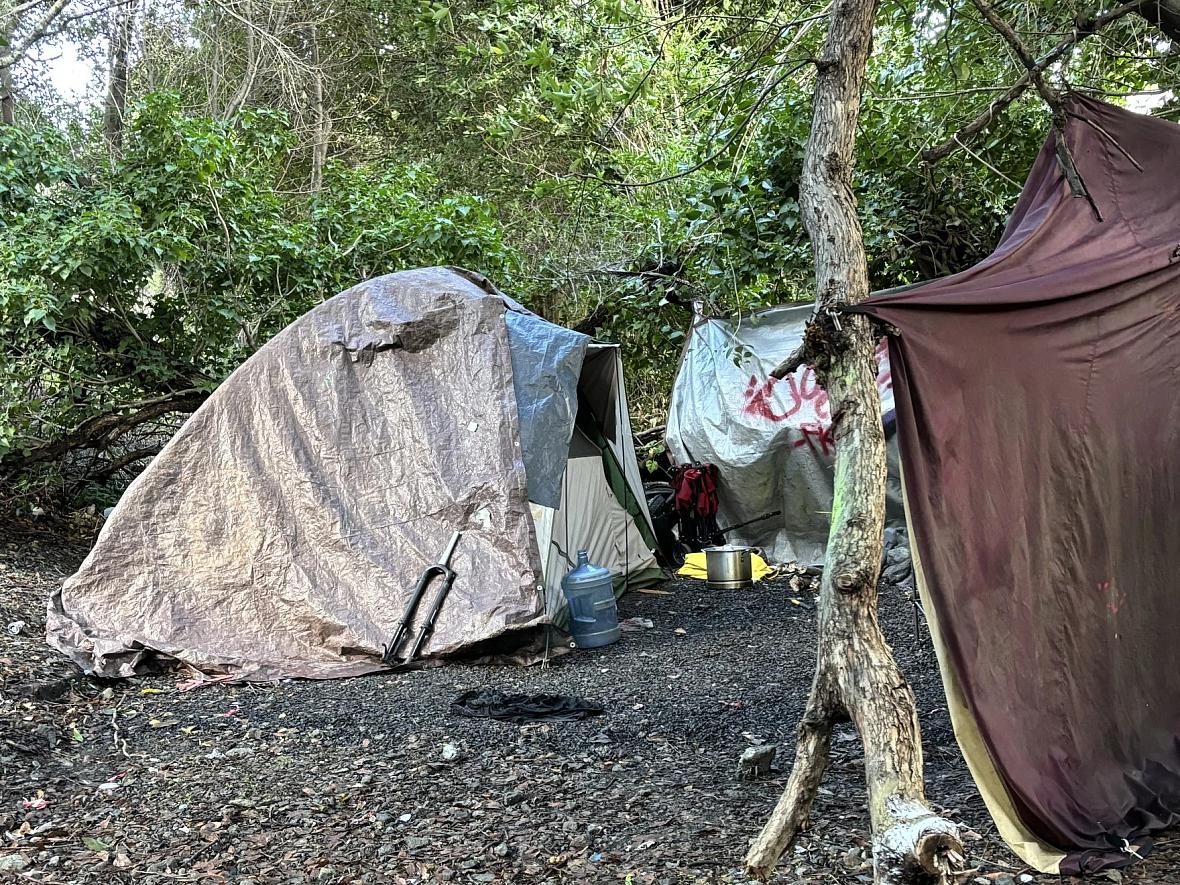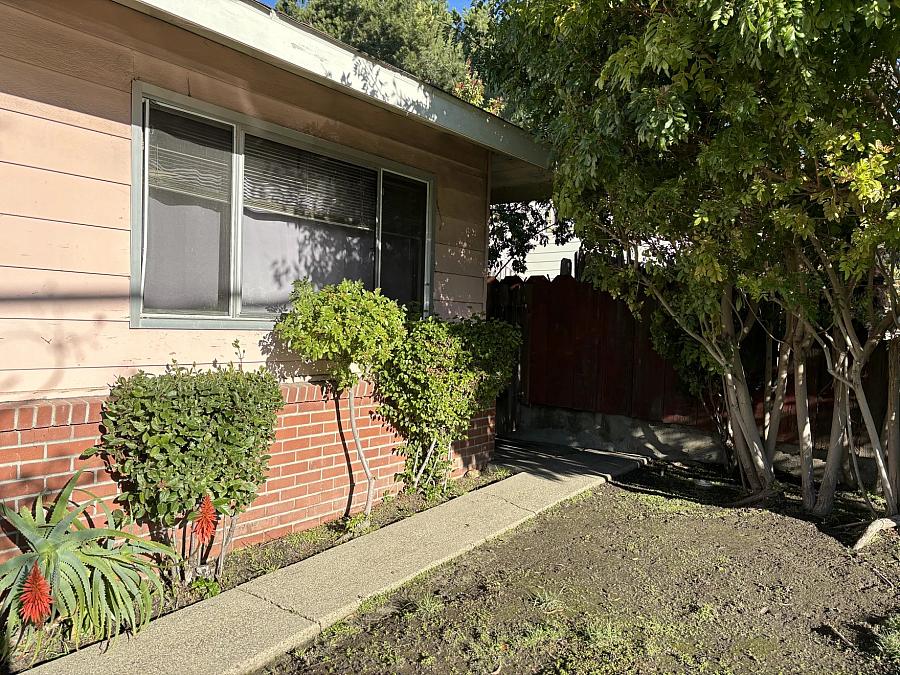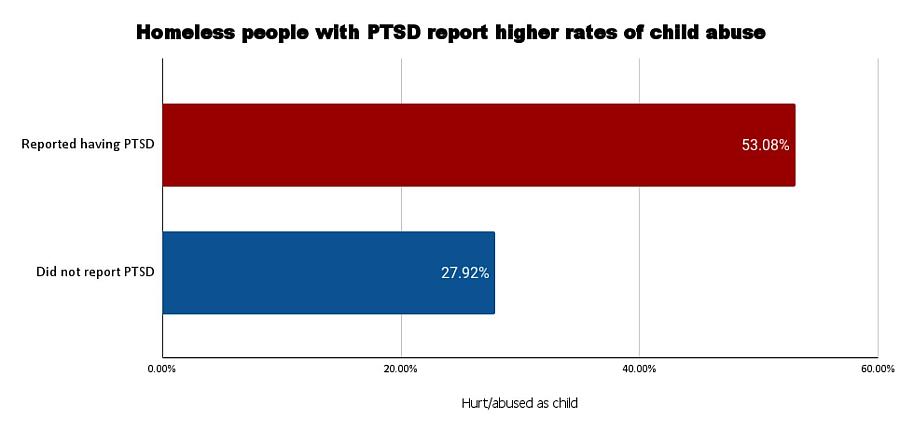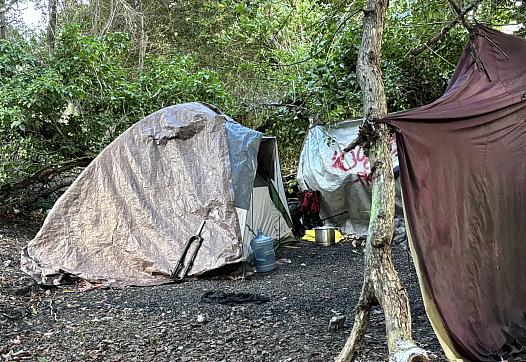Breaking the Cycle: Homelessness and PTSD in SLO County
The story was originally published by the KCBX with support from our 2023 Data Fellowship.

An encampment found during the 2024 Point-in-Time Count.
Photo By Amanda Wernik.
According to the 2022 Point-in-Time Count, almost half of San Luis Obispo County's homeless population who answered a question about PTSD, or post-traumatic stress disorder, said they had the condition.
To understand more about the mental disorder and its connection to homelessness, I visited a supportive housing facility managed by Transitions Mental Health Association (TMHA), a local nonprofit. Here, individuals experiencing homelessness find refuge and receive mental health support.
Inside, I met Chad Lamb, a 51-year-old resident who shared his experience of being homeless for over a decade.
“It's real difficult coming in off the streets after 15 years because you always have that doubt and waiting for the other shoe to drop,” Lamb said.
TMHA recently diagnosed Lamb with PTSD, a mental health condition that can develop after experiencing a traumatic event, like abuse or an accident.

TMHA's Housing Now supportive housing gives homeless people a safe place to stay while they receive mental health treatment.
Photo By Amanda Wernik
Lamb opened up about his childhood, revealing a history of physical abuse from his father.
“I've been beaten with cattle prods, welding rods, stingers. He’s beaten me unconscious. He's broken my bones a few times,” Lamb said.
Lori Eister, a therapist with TMHA, explained that people with PTSD often feel on edge, even in situations where there is no immediate danger.
“What happens in the brain when people go through trauma is fight, flight or freeze,” Eister said. “Our brains tell us that we're in danger, so people who have PTSD– their filters for danger don't work like people who don't have PTSD.”
“Their brains are constantly saying ‘danger danger danger,’” Eister added.
In TMHA’s Housing Now program, Lamb expressed feeling safe for the first time– but his eyes still darted around the room, scanning for danger.
“It’s been a struggle, but all in all, I'm actually pretty grateful because I have some place to be,” Lamb said.
More than half of the people in the PIT survey who reported having PTSD also said they were hurt or abused as a child– nearly double the rate of those who did not report PTSD.

53.08% of the people in the PIT survey who reported having PTSD also said they were hurt or abused as a child– nearly double the rate of those who did not report PTSD.
Graph By Amanda Wernik
Lamb said his father abandoned him when he was 17, forcing him to live on the streets. From there, his life became a blur, marked by periods of jail time, living in and out of shelters, and sustaining a traumatic brain injury from a fight.
But there's one childhood memory that he can’t forget, no matter how hard he tries.
“At age four I shot and killed my brother because of my father's ignorance,” Lamb said. “He didn't clear the weapons.”
Lamb remembered playing in his dad's work storage room with his brother, where they discovered a rifle on the top shelf. He climbed up to reach it.
To this day, he has flashbacks of his brother lying lifeless on the ground.
“His last words to me are still echoing in my head, and it's very haunting,” Lamb said, his voice breaking. “It can be very triggering at times.”
To be diagnosed with PTSD, The National Institute of Mental Health reports adults must experience several symptoms for at least one month, including:
- At least one re-experiencing symptom, like flashbacks.
- One avoidance symptom, such as avoiding reminders of the trauma.
- At least two arousal and reactivity symptoms, like being easily startled.
- At least two cognition and mood symptoms, including self-blame and social isolation.
Lamb shared that his PTSD symptoms have contributed to his long-term homelessness.
“I don't deal well with society because of my life, and it makes it super hard to be a part of anything,” Lamb said.
In the PIT count, the most common reasons people with PTSD reported experiencing homelessness were Covid-related issues and job loss. Another major reason many respondents checked off was “family and friends couldn't let me stay, or argument with family, friends, or roommates.”

Those who said they have PTSD were more likely to cite job loss and death of someone close as reasons for being homeless.
Graph By Amanda Wernik.
People with PTSD often struggle to maintain stable commitments because they perceive threats in every aspect of their lives, according to Eister.
“Any little bump in the road– their reaction to it can be a big blow up which has caused them to not be welcome in so many places, right?” Eister said. “Not welcome at the job; not welcome in the family; not welcome at the shelter; not welcome anywhere.”
After 15 tumultuous years of homelessness, Lamb is now confronting his trauma and staying sober with the help of TMHA.
Part two of the series will delve into why people with PTSD often experience recurring homelessness and the challenges they face in accessing help.


